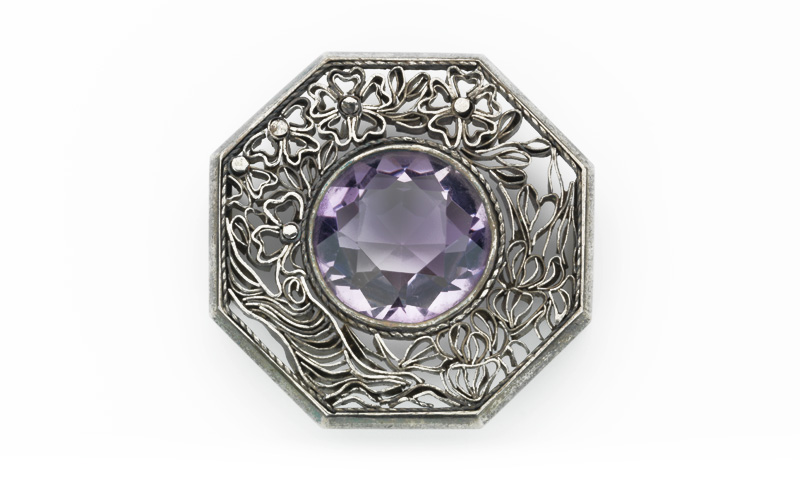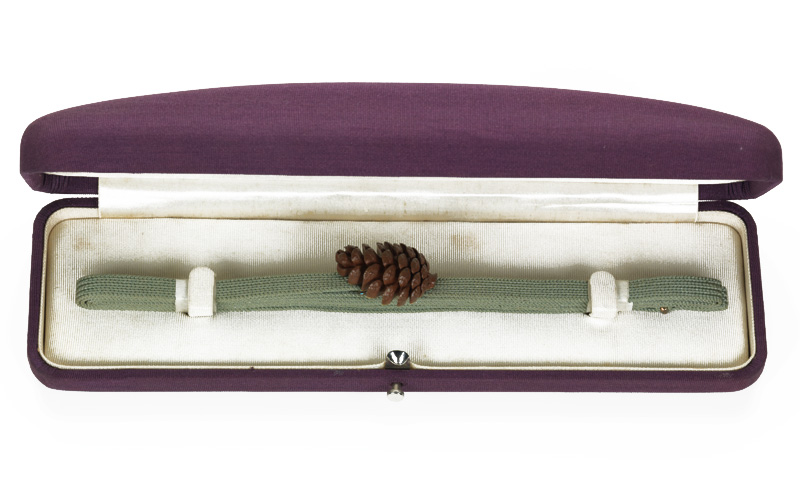日本のジュエリー史を考える
History of Japanese Jewelry
世界でも稀な特徴として、日本のジュエリー史は明治維新後、和装から洋装への転換後になってから始まりました。縄文時代から古墳時代までは、耳飾りや首飾りなどが着けられましたが、その後は 1300 年以上もの長い間、櫛(くし)や簪(かんざし)、や帯留のほかの装身具は発達しませんでした。
その理由は諸説ありますが、日本が誇る和装・着物に素晴らしく美しい図柄が施されていたので、それ以上飾る必要がなかったからともいわれています。また、ダイヤモンド等の宝石が産出されなかった事も理由の一つと考えられます。
明治以降のジュエリーをつくる技術の源泉は明治維新の遥か前、室町時代から 700 年以上にも渡って培ってきた刀装剣の技術にあると言えます。1876 年(明治9年)の廃刀令で職が無くなった刀職人達が錺(かざり)職人になりました。
従いまして、和彫りと言われるタガネと鎚(つち)をつかって手前に彫りこむ手法は、刀装剣の技術を元としたもので、西洋のジュエリー作りとは異なります。この技術のベースがあったからこそ、西洋からジュエリー文化が輸入されてわずか約 30 年で日本のジュエリーはキャッチアップできたと考えられます。
ウエダジュエラー
代表取締役社長
植田 友宏

平戸細工の帯留め(明治後期から大正時代)/A sash clip made by Hirado handiwork (late 1800s - around 1925)
中央のアメジストを囲むように平戸細工(銀製細工)が施された帯留めは大正時代の作品。恐らくウエダの刻印が入った作品の中では最古のもの。当時の社名の刻印は漢字。ウエダジュエラー製。
鈴木美彦作帯留め(大正から昭和初期)/A sash clip made by Yoshihiko Suzuki, a Japanese chaser (around 1910 - 1930)
鈴木美彦(1884 年~1969 年)作、松ぼっくりをかたどった帯留め。細密画に見られるような、細部に至るまでの緻密な植物描写と、小さく愛らしいものに愛情を注ぐ日本人らしさが生きた逸品。素銅(すあか)・K18。
The history of modern jewelry in Japan begins a bit after the Meiji Restoration (late 1800s), when people started wearing Western clothes rather than Japanese traditional kimono. People wore earrings or necklaces from the Jomon Period (around 131 BC – 4 BC) to the Kofun Period (around 250 – 700), but since then there had been no new personal ornaments other than combs, ornamental hairpins, and sash clips in over 1,300 years.
Some theorize that because Japanese kimonos were already adorned with beautiful patterns, there was no need to create new decorative accessories. Additionally, because decorative stones such as diamonds were not being mined in Japan, there was no way western style jewelry could be produced in old Japan.
Jewelry making techniques developed after the Meiji Period (1868 – 1912) were based on those of swordmaking, which have been continuously passed down for over 700 years since the Muromachi Period (1336 – 1573). In 1876, the Japanese government published Haitorei (the Sword Abolishment Edict) which strictly regulated laws regarding swords. As a result, many swordsmiths lost their jobs. With no other way to make a living, they started new lives making various metallic ornaments.
The swordsmith’s technique, called Japanese carving, uses a graver and hammer to engrave patterns. Thanks to an established tradition of technique and quality, within 30 years of introduction to Western jewelry culture, Japanese jewelry had caught up to Western Jewelry in terms of sophistication.
Uyeda Jeweller
President and CEO
Tomohiro Uyeda
参考文献 / Reference
『ジュエリーの歩み100年』露木 宏、関 昭郎、他、美術出版社、2005年
『日本装身具史』井上 洋一、露木 宏、関 昭郎、美術出版社、2008年
『超絶技巧!明治工芸の粋』浅野研究所、2014年
『幕末・明治の鐔・刀装金工』村田 理如、マリア書房、2008年
『SINCE1884年』植田商店、1994年
"100-year history of jewelry" Hiroshi Tsuyuki, Akio Seki, BIJUTSU SHUPPAN-SHA Co.,LTD. (2005)
"History of Japanese personal ornaments" Hiroshi Tsuyuki, Akio Seki, BIJUTSU SHUPPAN-SHA Co.,LTD. (2008)
"Virtuoso! Chic beauty of Meiji handicrafts" Asano Laboratories, Inc. (2014)
"Handguard/Sword equipment metal art in the last Edo and Meiji period" Masayuki Murata, Maria Shobo Co.Ltd (2008)
"SINCE 1884" Uyeda & Co. (1994)
